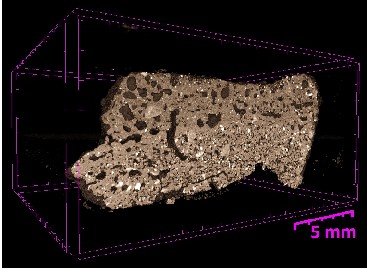1. Introduction
Desert soils occupy approximately 46.1 million square kilometers, or 31.5% of the Earth’s surface (Dregne, 1976). In Asia, they constitute about 33% of the total area; in North America, 18.5%. The desert varnish and the vesicular crust horizon are distinctive morphological features of desert landscapes, and generally recognized features of desert pedogenesis. Various symbols are used to designate specific surface horizons of extremely arid soils. Since 1958, surface vesicular horizons have traditionally been designated as Av (vesicular) horizons (Springer, 1958). According to the World Reference Base for Soil Resources (WRB) (2014), this surface horizon has yermic diagnostic properties (earlier, it was identified as a yermic diagnostic horizon) designated by the yermic qualifier (ye) of desert soil subgroups in different reference soil groups (WRB, 2014). Regarding Soil Taxonomy, it has recently been suggested (Turk and Graham, 2011, 2014) that a vesicular horizon (epipedon) should be added to this classification system. In the absence of desert pavement, it corresponds to the nudiyermic (ny) qualifier. Yermic properties are diagnosed by the presence of a pavement and/or a vesicular layer in combination with aridic properties reflecting the activity of aeolian processes, a low humus content, and a high (> 75%) base saturation (WRB, 2014). In the study of extremely arid soils of Kazakhstan (Lebedeva et al., 2015), these horizons were referred to as vesicular crust horizons.
Currently, there is a great international interest in the problem of genesis of the Av vesicular horizon (synonym: vesicular crust, which is often used in the literature) of arid soils, because it is considered an indicator of degradation or desertification of arable soils, as described in the review by Pagliai and Stoops (2010). However, most of the published studies concern the microfabric of surface horizons in the soils of subtropical deserts. Much less is known about the extremely arid soils and their micromorphological features in the subboreal zone of Central Asia (Gunin, 1990; Mees and Singer, 2006; Lebedeva et al., 2009; Gerasimova and Lebedeva, 2010).
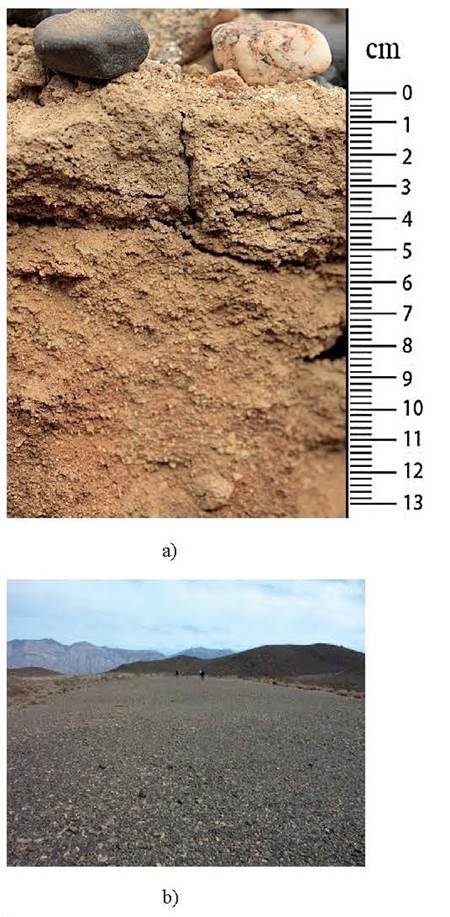
Figure 1 The Mojave Desert: a) the profile of extremely arid soil: desert pavement rock fragments of various colours at the surface, underlain by soil horizons as follows: Av (0 - 5 cm), ABvky (5 - 8 cm), Btky (8 - 13 cm) (pit PAN - 28); b) the level surface of an ancient piedmont plain with desert pavement.
The upper fine-earth horizons under gravelly desert pavements are characterized by a high density (for that reason, they are referred to as crusts) and by the predominance of isometric vesicular pores. The contents of fine silt and clay particles in the surface fine-earth horizons are considerably higher than in the underlying horizons. This is often explained by the aeolian input of fine particles with their accumulation under the scattered gravels and coarser fragments of the desert pavement (Evstifeev, 1977, 1980; Pankova, 1992; Glazovskaya and Gorbunova, 2003; Lebedeva et al., 2009, 2015; Pankova and Gerasimova, 2012; McDonald et al., 2014). The allochthonous nature of aeolian dust in the upper horizon of extremely arid soils of Mongolia was confirmed by mineralogical studies of the clay and silt fractions (Chizhikova et al., 1988).
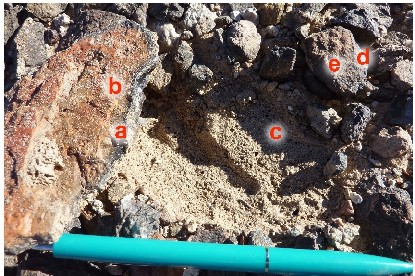
Figure 2 Colour variations in films on rock fragments from desert pavements of ancient piedmont plains of the Mojave Desert (pit PAN-28); the rock fragments are set in the fine-earth material of the Av horizon: (a) varnish at the edge of the lower side of broken stones; (b) the brownish-red lower surface of broken stone “sealed in” Av horizon; (c) horizon, opened after the raising of broken stone; (d) the darker selvedge of the broken stone surface; (e) the lighter central part of the broken stone surface.
The study of desert varnish on rock fragments has a long history. This specific feature was first described by Humboldt in 1852 (cited by Perry and Kolb, 2003); later, it attracted attention of Darwin (1860). According to Dorn (2009), there are different types of desert varnish films (coatings,cutans) depending on their composition, with the following principal constituents-clay minerals,silt, calcite, iron and manganese oxides, silica and trace elements. The concentrations of iron and manganese oxides predetermine the colour variations in such films-from orange to virtually black (Potter and Rossman, 1977, 1979; Krinsley et al., 1995; Dorn, 2009).
The genesis of desert varnish is most commonly explained by weathering of rock minerals with the participation of epilithic and endolithic microorganisms (Glazovskaya, 2002; Mergelov et al.,2012). Another common explanation is the accretion of fine particles on the rock surface with further cementation of the accumulated material by iron and manganese oxides with the participation of lithobionts (lichens, cyanobacteria and other organisms) (Friedmann and Weed, 1987; McKeown and Post, 2001; Perry et al., 2006; Lebedeva and Shishkov, 2016).
Some cases of layered desert varnish were reported, where the development of a complex microstratigraphic sequence of such layers (microlaminations) was explained by changes in climatic conditions (Liu and Broecker, 2007, 2008; Dorn, 2009).
Arid soils with a vesicular crusty horizon are widespread in the US deserts. They have been studied in detail, including the studies in the Mojave Desert (Blackburn, 1975; McDonald, 1994). The analysis of a great number of soil profiles (> 1000) from the Mojave Desert showed that the thickest vesicular horizons are developed under desert pavement on piedmont plains with the age of more than 40 ka (McFadden et al., 1986, 1998; McDonald, 1994; McDonald et al., 2014). Likewise, a clear vesicular porosity is consistently present under desert pavement with well-developed desert varnish in the Gobi Desert. The vesicular pores have larger sizes, while the surface horizon has lighter (paler) colour compared to the underlying horizons (Evstifeev, 1977, 1980; Lebedeva-Verba et al., 2009).
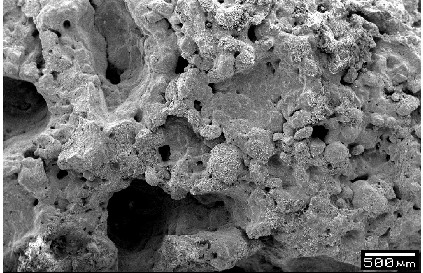
Figure 3 The ancient surface of the Av horizon with pores covered by ‘amorphized’ clay coatings (Gobi Desert, Mongolia; SEM) (Lebedeva-Verba et al., 2009).
The aim of this article is to present a new possible mechanism of the development of desert varnish associated with processes in the Av horizon.
2. Materials and methods
2.1. Materials
Extremely arid soils in the Mojave and Trans-Altai Gobi deserts located on different continents and in different climatic zones (subtropical and boreal zones, respectively) were studied.
During the field trip of the International Union for Quaternary Research (INQUA) Project Group RAISIN to the Mojave Desert in 2014, samples from the desert pavement and vesicular crust horizon were taken on the most ancient alluvial fans of the three most ancient (Early and Middle Pleistocene) piedmont plains in the areas devoid of higher plants (McDonald et al., 2014). This is, in the eastern part of the desert at the foot of the Providence Mountains (pit P-18, 53-65 ka), on the Cima volcanic field (pit Cim on the lava flow of 75-85 ka in age), and in the south-western part of the desert in the Panamint Valley (pit PAN-28, 75-85 ka). Detailed information on these pits is given in the field guide (McDonald et al., 2014). Fragments of volcanic rocks predominated in the composition of desert pavements.
The desert pavements were formed by felsic volcanic rocks (spherulitic rhyolite or quartz-rich rhyolite (aporhyolitic microquartzite)) in both deserts, except for the Cima volcanic field with a predominance of olivine basalts.
Table 1 The main micromorphological features of the topsoils.
| Desert | pit | Voids | Groundmass c/f related distribution | Micromass b-fabric | |||
|---|---|---|---|---|---|---|---|
| v | pl | pv | ch | ||||
| Gobi (Mongolia) | 10 | +++ | + | + | + | fm-op | gs-cr |
| UG-24 | +++ | + | ++ | + | fm-op | gs-cr | |
| Mojave (USA) | P-18 | +++ | - | + | + | cp | cr |
| PAN-28 | +++ | ++ | + | + | sp | gs-cr-ss | |
| Cim | +++ | + | +++ | + | fm-sp | gs-cr | |
| pit | Pedofeatures | |||||||
|---|---|---|---|---|---|---|---|---|
| carbonate | clay | inter | Fe/Mn | matrix Impregnation | matrix depletion | organic matter | ||
| mi | other types | |||||||
| 10 | w | - | c-p | - | nt(++) | + | +++ | clr |
| UG-24 | m | crs | c | ++ | nd(+) | + | - | p |
| P-18 | w | - | p-c | - | nd(+) | + | + | p, or |
| PAN-28 | s | im | p-c -df | - | nd (+) | +++ | ++ | p, or |
| Cim | m | nt | c-p | ++ | nd(+) | + | - | or |
-, +, ++, +++ Indicate increasing frequency of pedogenic features: - = absent, + = rare (locally in separate zones), ++ = common, +++ = abundant.
Void: v = vesicular, pl = planes, pv = packing voids, ch = chamber.
Groundmass c/f related distribution: fm=fine monic, sp= single spaced porphyric, dp=double porphyric,; cp= close porphyric,; op = open porphyric.
Micromass: b-fabric - cr = cristallitic, ss = stipple speckled, gs = granostriated.
Pedofeatures: c = coating; p = papule (fragment of clay coating); inter = intercalation; im- impregnation; df = deformed pedofeatures; mi = micrite in groundmass (degree of impregnation: w = weakly; m = moderately; s = strongly);
nt = typic nodule; nd = dendritic nodule; crs = crystal intergrowths; Organic matter: clr = cell residue, p = punctuations, or = organ residue.
Their microscopic features were compared with the features of desert varnish and vesicular crust (Av) horizon from the Gobi Desert, where the samples were collected by the authors and E.I. Pankova.
Two extremely arid soils (pits 10 and UG-24) on proluvial sediments with a considerable admixture of red-coloured Cretaceous and Paleogene saline rocks were studied on a gentle southern slope of the Tsagan-Bogdo Mountains (Gobi Tien Shan).
Detailed descriptions of characteristic microfeatures of these two soil profiles have already been published by the authors: pit 10, Lebedeva et al. (2009); pit UG-24, - Lebedeva et al. (2016). In addition, the microscopic features of desert varnish on two rock fragments from desert pavement of pit 213 were examined. According to Pankova (1992), the soil profiles exposed in pits 10 and 213 were genetically similar.
All the studied soils were classified according to the WRB system (2014) as Skeletic Luvisols (Aridic, Cutanic) with horizons Avk-ABvk-Btky-BCky-CBky (Figure 1a).
A specific feature of the arid climate of the Gobi Desert is its high continentality, with the soil freezing depth of 60-100 cm and occasional rainfalls in summer (Pankova, 1992). In the Mojave Desert, the soils do not freeze, because mean January temperatures rarely fall below 0 °C (except for the valleys, where they may be as low as -7 °C), and precipitation mainly takes place in autumn and winter. In summer, the temperature of the soil surface reaches 54°C and more, with the daily amplitude of temperatures up to 26°C; therefore, the role of condensational moisture is very important in the hot summer months.
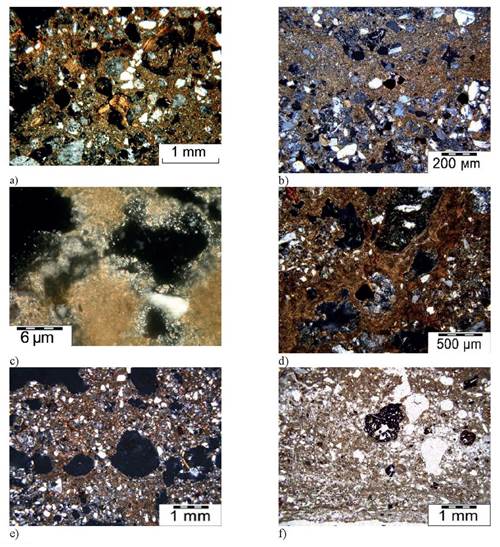
Figure 4 The microfabric of the Av horizons under the pavements in extremely arid deserts of Gobi (a - c) and Mojave (d - f): (a) predominance of vesicular pores with laminated clay coatings in weakly calcareous sandy-clayey material (pit 10, XPL); (b) vertical heterogeneity of distribution of sand, silt and clay particles (pit UG-24, PPL); (c) iron depletion pedofeatures around pores within groundmass (pit 10, XPL); (d) large vesicular pores in clayey calcareous material, inclusions of fragments of sandstone and calcareous rocks, clay intercalations (pit PAN 28, XPL); (e) large vesicular pores in silt-clay material, an abundance of fragments of clay coatings (pit P18, XPL); (f) microlayered distribution of clay particles within silty material, vesicular pores near highly ferruginous small fragments of olivine basalts (pit Sim, PPL).
The extreme aridity of the studied territories is clearly reflected in the character of vegetation. On the studied piedmont plains with hamadas, higher plants are absent (Figure 1b). According to Zolotokrylin (2003, 2008), the aridity effect can be enhanced by desert pavements. During the summer, due to the black colour of coatings the surface of desert pavements is heated stronger than the surface of loamy and sandy substrates.
2.2. Methods
Thin sections from rock fragments and from the vertically oriented undisturbed samples (soil monoliths) of the surface soil horizons were prepared in the Laboratory of Mineralogy and Micromorphology of Soils of the Dokuchaev Soil Science Institute by M.A. Lebedev. As the surface horizons had a limited thickness, their thin sections had an area of only 2 - 4 cm2. These thin sections were prepared in four replications. Micromorphological examination of thin sections was performed with an Olympus BХ51 optical microscope equipped with an Olympus DP26 camera. Descriptions were made with the use of international guidelines (Stoops, 2003).
A submicroscopic study was performed using a JEOL JSM-6610LV scanning electron microscope with an INCA Energy X-ray microanalyzer. Additionally, we mapped the patterns of element distributions in the loci with morphologically pronounced cross-sections of desert varnish in the cut rock faces. Special attention was paid to distribution patterns of iron and manganese in the studied thin sections. To supplement the results of morphological observations (as the mapping of the elements of microstructure does not give us information on the real concentrations of the elements), microprobe X-ray spectroscopy was performed, especially, in the loci with high concentrations of iron or manganese.
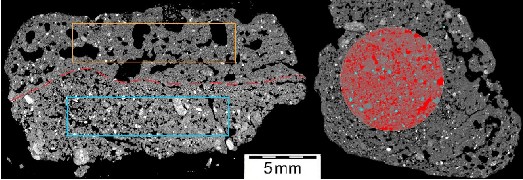
Figure 6 The 3D shapes used in calculating porosity and solid phase parameters per volume unit (Gobi, Mongolia). Left - a vertical cross-section with marked (red) boundary between the upper and the lower parts of the sample, where selections are marked in orange and blue. Right - a horizontal cross-section fragment with one of selected shapes (view from above, marked in red).
A microtomographic study of the soil structure was performed on the SkyScan 1172 microtomograph at the V.V. Dokuchaev Soil Science Institute, at image resolution of 5 μm per pixel. This non-destructive method allows us to confidently determine the internal structure of soil samples, separate pores and the solid phase (up to separate structural formations-individual microaggregates, concretions, mineral grains, etc.) with a high degree of reliability. Tomographic data were processed in CTvox software (the volume structure of the sample) and CTan (volume morphometric values).
General chemical and physicochemical properties of compared soils were estimated from published data (Pankova, 1992; McDonaldet al., 2014).
3. Results
3.1.1. Macrofabric of topsoils
All the Av horizons studied under desert pavement, compared to underlying horizons, were characterized by a clear vesicular porosity, medium compaction, and a light colour (most often, whitish pale) (Figures 1a, 2).
3.1.2. Micro- and submicrofabric of topsoils
Micromorphological analysis (Table 1) showed that high amounts of isolated round pores could be present in horizons with different contents of salts and carbonates, different degrees of development of clay coatings on pore walls and different degrees of vertical heterogeneity of coarse fraction contents. The scanning electron microscopic analysis revealed that walls of many pores are covered by very thin, dense and non-layered clay coatings, invisible under an optical microscope (Figure 3). The comparative analysis of many thin sections from extremely arid soils demonstrated that round-shaped vesicular pores occur mostly within microzones with fine monic coarse/fine related distribution (c/f; Stoops, 2003) while the groundmass has a porphyric c/f related distribution (Figure 4, Table 1). The specific micro-features, such as the forming of iron-depleted zones around pores (Figure 4c), were revealed within the horizons with relatively low carbonate content.
3.1.3. The X-ray tomography of the Av horizon structure
On the basis of the tomographic analysis of separate cross-sections and resulting 3D reconstruction of a sample from the Av horizon (Gobi, Mongolia), it was revealed that the sample is subdivided by a clear boundary into two parts (upper and lower) with different characteristics of pores and aggregates (Figure 5).These two parts were subjected to separate analyses (porosity and solid phase distribution) with subsequent comparison of the data obtained.
Table 2 3-D parameters based on the tomographic analysis of the top and the bottom parts of the crust.
| 3-D parameters | Top | Bottom |
|---|---|---|
| Number of tomographic cross sections used in the 3D-structure analysis | 173 | 151 |
| Resolution (μm) | 10.36 | 10.37 |
| Total selected volume of sample (mm3) | 73.98 | 64.58 |
| Number of solid-phase objects per 1 mm3 | 40.34 | 195.18 |
| Number of closed pores per 1 mm3 | 339.52 | 1110.18 |
| Total number of pores per 1 mm3 | 391.84 | 1172.7 |
| Number of contacts between objects per 1 mm3 | 105.79 | 511.26 |
Calculations were carried out using the CTan programme for selected volumes as indicated in Figure 6. The selected 3-D shapes were 700 pixels (7 mm) in diameter and 150-170 pixels high. In the data presented below, the two parts of the horizon studied are also referred to as the ‘top’ and the ‘bottom’ of the vesicular crust.
Quantitative parameters of the top and the bottom of the vesicular crust are significantly different. In comparison to the lower part, the upper part has 2-3 times lower numbers of pores, but the total porosity is 2 times higher, due to the larger pore size (Table 2, figures 7, 8).
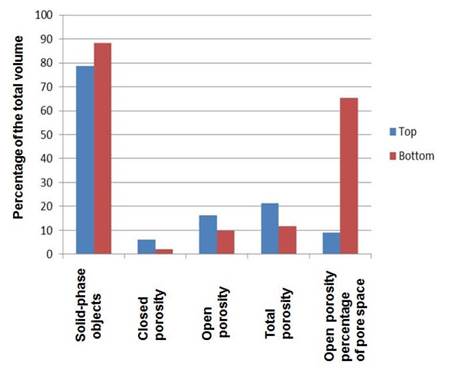
Figure 7 3-D parameters based on the tomographic analysis of the upper and the lower parts of the crust (volume %).
There is a higher content of solid-phase units (1/mm3) within the bottom of the Av horizon compared to its surface (Table 2). This corresponds to the higher looseness of solid phase units packs in the lower part of the horizon.
The upper part of the crust horizon is characterized by the presence of large vesicular pores that are isolated from smaller pores and each other. Their development was accompanied by the compaction of the solid phase: the content of micropores less than 50 µm in size is very low (no more than 5% of the total pore volume) (Figure 8).
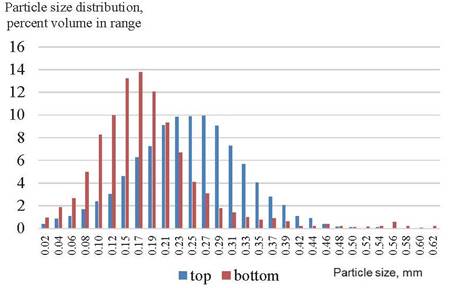
Figure 8 Average pore sizes and their proportion in the total pore space volume within the upper (blue) and the lower (orange) parts of the crust horizon.
Despite a high percentage of open porosity, vesicular pores are completely isolated from each other, as was is shown at 10 µm resolution (Figure 4c). The structure of the upper part of the crust resembles a compressed frozen foam. Its surface vesicles are open and partly filled with soil particles (Figure 6). Micropores are prevailing (up to 70% of the total pore space) within the lower part, but almost absent within the upper part. In the lower part, no pores larger than 250 µm were found (Figure 8). The pore space connectivity values in the top and bottom parts are especially different. The 9% connectivity of pore space (Figure 7) is indicative of a very low infiltration capacity of the upper part of the crust horizon of desert soil.
3.2.1. Macrofabric of desert varnish films
The upper sides of all studied rock fragments are covered by dark glossy desert varnish films (Figure 2). The lower sides of rock fragments are set into dense light-coloured vesicular crust horizon and had brown or red-brown (in the Mojave Desert samples) colour, through which the initial rock colour can be seen (in the Gobi Desert samples). In the field, the difference between the compared deserts was seen in a higher fissuring of coarse rock fragments of desert pavements in the Mojave Desert in comparison with that in the Gobi Desert.
3.2.2. Microfabric of desert varnish films
Under the polarizing microscope, thin brown or reddish-brown films are seen in plain polarized light; they are isotropic in crossed polarized light. This type of desert varnish predominates among the studied samples. It can be found on rock fragments of different mineralogical composition, including basaltic lavas of the Cima volcanic field (Figure 9). The upper part of the desert varnish on this fragment consists of two different layers: an upper newly formed cryptograined silica layer and a lower ferriferous layer with moderately developed crumb microstructure (Figure 9e).
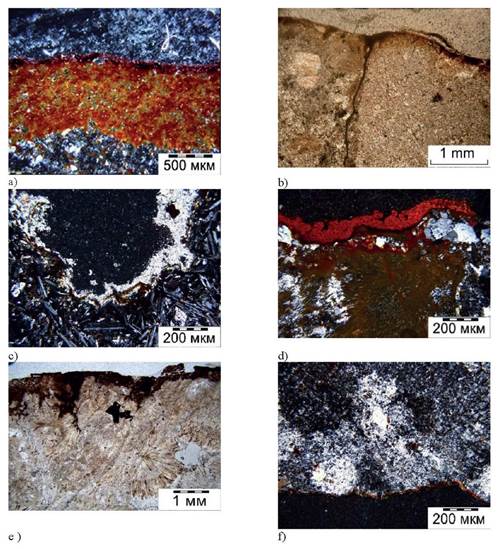
Figure 9 The microfabric of desert varnish films on rock fragments from desert pavements of Gobi (a, b) and Mojave (c - f): (a) Si-Mn- Fe film on sandstone (PPL); (b) thin film of desert varnish on the upper surface of a rock fragment from the desert pavement - the thickness of this ferruginous film is increased within microcavities, ferruginous compounds penetrate inside the rock fragment (PPL); (c) two-layered film on the upper surface of the fragment of lava (olivine basalt): the upper layer - relatively thick, fine-grained, silicate-carbonate; the lower layer - thin, ferruginous (the Sima Plateau, U.S.A.) (PPL); (d) thick multilayered ferruginous film on the surface of the rock fragment (aporhyolitic quartzite) with a fan-like penetration into the rock (PPL); (e) ferruginous film of varied thickness on the upper surface of the rock fragment (spherolithic rhyolite) with continuous desert varnish; ferruginous compounds penetrate inside the rock fragment along cracks (PPL); (f) thin anisotropic clay coating on the lower side of the rock fragment (ignimbrite) from the desert pavement (PPL).
The thickness of the films increases above fissures dissecting felsic rocks (Figure 9) both in the Gobi and Mojave deserts. In general, the thickness of such films and the frequency of their occurrence are higher in the Mojave Desert. In this desert, they penetrate deeper into the fissures of rock fragments. Under such films, the zones of iron accumulation in the form of iron pseudomorphs at the contact of light-coloured minerals (quartz and feldspars) are seen. A specific feature of desert varnish films inside cavities in the basaltic lava is that they are covered by fine-grained silicates and carbonates (silicate-calcitic coatings) of presumably aeolian genesis (Figure 9c).
The surface of some rock fragments in the Mojave Desert is covered by discontinuous “spotty” desert varnish films. Under the microscope, these are thick red-coloured anisotropic films having a sharp contact with the underlying spherulitic rhyolite (Figure 9d). The optical properties of these films suggest the predominance of hematite in their composition.
The lower sides of rock fragments are plunged into the fine-earth vesicular crust horizon. The films on their surface are anisotropic and have the striated fabric typical of the iron-clayey micromass. The contact of these films with the dark-coloured olivine basalts (pit Cim) containing titanomagnetite and other iron minerals (Figure 9f) is especially distinct.
3.2.3. Submicromorphology of desert varnish films
Electron microscopy and microprobe analysis (tables 3, 4; Figure 9) also confirms a considerable similarity of desert varnish on the surface of rock fragments in both deserts. Most of the desert varnish films on convex and smooth parts of the rocks are one-layered and consist of silica, manganese, and iron. Two-layered films are developed in the rock cavities (Figure 10). In the lower layer of two-layer films, Mn prevails and Ba is present, and in the upper layer Fe prevails and Ti appears. Furthermore, the composition of all the films of desert varnish does not depend on the composition of rock fragments, whose surface they cover (tables 3, 4).
Table 3 The elemental composition of single-layered films of desert varnish in Mongolia and USA on different surfaces of rock fragments (mass %).
| Loci | Pit no. | Film | Cut rock inder the film | ||||||||
|---|---|---|---|---|---|---|---|---|---|---|---|
| Fe | Mn | Ti | Si | Al | Fe | Mn | Ti | Si | Al | ||
| Gobi (Mongolia) | |||||||||||
| Upperside of stone | 10(1)* | 3.69 | 0.72 | 0 | 21.34 | 4.24 | 3.38 | 0 | 0 | 32.93 | 3 |
| 10(2) | 5.07 | 0 | 0.26 | 18.41 | 6.22 | 1.36 | 0 | 0 | 27.75 | 10.23 | |
| 213(1) | 4.21 | 0.84 | 0 | 18.94 | 4.21 | 2.1 | 0 | 0 | 35.83 | 2.43 | |
| 231(2) | 2.49 | 1.82 | 0.22 | 21.76 | 5.56 | 1.37 | 0 | 0 | 34.87 | 6.2 | |
| Lava 10(1) | 3.91 | 0 | 0.39 | 19.09 | 7 | 5.63 | 0 | 0.16 | 22.09 | 6.76 | |
| Lava 10(2) | 2.82 | 0 | 0.69 | 15.37 | 3.73 | 5.36 | 0 | 0.26 | 20.12 | 6.35 | |
| Lower side of stone | 10(1) | 1.7 | 0 | 0.27 | 16.35 | 4.08 | 0.68 | 0 | 0 | 28.21 | 5.62 |
| 10(2) | 2.3 | 0 | 0.18 | 13.97 | 5.72 | 0.73 | 0 | 0.17 | 19.79 | 5.1 | |
| 213(1) | 2.81 | 0 | 0.39 | 17.99 | 5.78 | 0.7 | 0 | 0 | 26.99 | 6.86 | |
| 231(2) | 0.98 | 0 | 0.21 | 19.09 | 3.83 | 0.42 | 0 | 0 | 27.19 | 6.59 | |
| Mojave (USA) | |||||||||||
| Upperside of stone | Pan-28(1) | 3.64 | 0.91 | 0.26 | 22.83 | 6.36 | 0 | 0 | 0 | 27.8 | 4.3 |
| Pan-28(2) | 2.89 | 2.22 | 0.21 | 18.37 | 5.43 | 0 | 0 | 0 | 28.97 | 5.14 | |
| Pan-28(3) | 2.51 | 0 | 0.12 | 11.97 | 5.64 | 0 | 0 | 0 | 30.42 | 4.78 | |
| Cim(1) | 3.88 | 0.76 | 0.54 | 17.27 | 7.88 | 8.11 | 0 | 1.4 | 20.64 | 7.92 | |
| Cim(2) | 5.16 | 1.28 | 0.9 | 15.91 | 7.38 | 5.64 | 0 | 1.91 | 21.68 | 9 | |
| Cim(3) | 5.78 | 6.68 | 0.54 | 17.06 | 8.03 | 10.6 | 0 | 3.65 | 16.9 | 8.49 | |
| Lower side of stone | Pan-28(1) | 3.16 | 0 | 0.19 | 16.7 | 5.4 | 0 | 0 | 0 | 27.8 | 4.3 |
| Pan-28(2) | 2.7 | 0 | 0 | 24.72 | 6.64 | 0 | 0 | 0 | 28.97 | 5.14 | |
| Pan28-(3) | 2.42 | 0 | 0 | 23.18 | 7.2 | 0 | 0 | 0 | 30.42 | 4.78 | |
| Cim(1) | 4.9 | 0 | 0.85 | 18.9 | 10.16 | 7.19 | 0 | 1.91 | 19.72 | 10.11 | |
| Cim(2) | 5.51 | 0 | 0.86 | 18.33 | 9.55 | 9.23 | 0 | 3.59 | 14.18 | 6.6 | |
| Cim(3) | 3.87 | 0 | 0.3 | 14.86 | 8.11 | 10.73 | 0 | 3.7 | 17.33 | 8.7 | |
* Different sampling loci on the same stones from desert pavement are indicated in parentheses. Lava in the Gobi Desert denotes a fragment of dark-coloured rock with vesicular surface from all sides. This rock fragment was present among other rock fragments in pit 10.
Table 4 Element concentrations (wt.%) in different parts of two-layered desert varnish films found in microlows on top sides of rock fragments of desert pavements in Mongolia and the United States.
| Pit no. | Upper layer of the film | Lower layer of the film | Cut rock under the film | |||||||||||||||
|---|---|---|---|---|---|---|---|---|---|---|---|---|---|---|---|---|---|---|
| Fe | Mn | Ba | Ti | Si | Al | Fe | Mn | Ba | Ti | Si | Al | Fe | Mn | Ba | Ti | Si | Al | |
| Gobi (Mongolia) | ||||||||||||||||||
| 213(1)* | 5.78 | 0.62 | 0 | 0 | 21.5 | 6.36 | 1.76 | 19.52 | 4.69 | 0 | 15.66 | 6.25 | 0 | 0 | 0 | 0 | 30.1 | 4.61 |
| 213(2) | 10.8 | 2.09 | 0 | 0.36 | 23.2 | 7.76 | 0.72 | 3.76 | 0.81 | 0 | 33.13 | 4.18 | 0 | 0 | 0 | 0 | 39.28 | 3.42 |
| 213(3) | 7.86 | 0.58 | 0 | 0 | 22.88 | 5.97 | 2.05 | 5.93 | 1.71 | 0 | 13.79 | 5.44 | 0 | 0 | 0 | 0 | 31.9 | 6.56 |
| Mojave (USA) | ||||||||||||||||||
| Pan-28(1) | 15.95 | 1.51 | 0 | 0.47 | 16.1 | 8.43 | 1.3 | 19.32 | 4.39 | 0 | 9.53 | 5.39 | 0 | 0 | 0 | 0 | 32.08 | 6.52 |
| Pan-28(2) | 8.5 | 1.95 | 0 | 0.22 | 15.1 | 6.77 | 0 | 17.21 | 3.24 | 0 | 12.95 | 5.51 | 0 | 0 | 0 | 0 | 30.33 | 4.9 |
| Pan-28(3) | 5 | 0.38 | 0 | 0.24 | 18.33 | 3.61 | 1.08 | 11.33 | 2.49 | 0 | 10.8 | 6.44 | 0 | 0 | 0 | 0 | 30.6 | 4.17 |
| Cim(1) | 9.35 | 0.47 | 0 | 0.42 | 18.08 | 8.7 | 3.29 | 14.08 | 1.71 | 0 | 14.5 | 7.63 | 8.1 | 0 | 0 | 1.4 | 20.64 | 7.92 |
| Cim(2) | 11.89 | 1.15 | 0 | 0.85 | 20.28 | 7.01 | 0.86 | 7.2 | 0.87 | 0 | 13.63 | 7.26 | 11 | 0 | 0 | 3.7 | 21.68 | 9 |
* Sampling loci on rock fragments are indicated in parentheses.
4. Discussion
Combined micromorphological studies of desert varnish and the vesicular horizon of extremely arid soils developed within the ancient piedmont plains of the Mojave Desert and the Trans-Altai Gobi Desert have revealed a large complex of similar elements of microfabrics (Lebedeva and Shishkov, 2016).
The vesicular crusts are enriched in silt and clay particles due to aeolian transport and accumulation of such particles under rock fragments of desert pavement (after McDonald, 1994; McDonald et al., 2014). Additionally, physical weathering of proluvial sediments under alternating conditions of heating-cooling and wetness-dryness contribute to the silt and clay enrichment. The previous, caused these sediments to become increasingly silty (Cooke, 1970, Konischev, 1981), calcareous (due to secondary calcium carbonate accumulation, Glazovskaya, 1988) and sometimes saline. These factors are favourable for the development of vesicular porosity.
Several mechanisms of the formation of vesicular porosity are discussed in the literature:
■. Displacement of soil air by an advancing wetting front (Springer, 1958, Dietzeet al., 2012),
■. Displacement of adsorbed air by rainwater (Gorbunov and Bekarevich, 1955, Lebedevaet al., 2009, 2016),
■. Changes in calcium bicarbonate equilibrium (Ca(HCO3)2 CaCO3+ CO2+ H2O) (Paletskayaet al., 1958).
Clayey and calcareous coatings in the pores of Av horizon on a microlevel were described for many topsoils of desert soils. They were also described for Cima plateau (Anderson et al., 2002). We relate the origin of clayey coatings to the local clay mobility under extremely alkaline conditions (pH > 9) during the rainy season (Glazovskaya and Gorbunova, 2003).
Calcareous coatings are formed due to precipitation of carbonates on the pore walls at the evaporation of the salt solutions entering from below (Figure 9c).
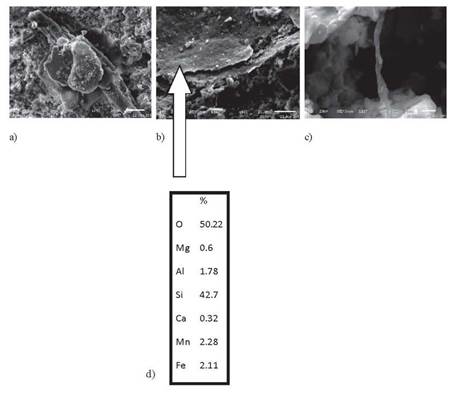
Figure 10 The biogenic and illuvial microfeatures of desert varnish within a cavity on the upper side of a rock fragment from the desert pavement (SEM, Gobi, pit 10): (a) microfossils under biotite layers; (b) Mn-Fe-Si two-layered illuvial film with filamentous bacteria underneath; (c) filamentous form of iron bacterium under an illuvial film of desert varnish; (d) elemental microprobe analysis of the central part of the film.
Microtopographic distribution of the soil pits also affects the degree of coating formation. Their maximal thickness was revealed within the soils of the lower parts of microslopes, which confirms the possible lateral migration of salty solutions and materials in suspension. In any case, the presence of any coatings on the walls of vesicular pores in Av horizons makes them more temporally sustainable (Sullivan and Koppi, 1991; Turk and Graham, 2014).
Under extremely arid desert conditions, the amount of moisture falling onto the soil surface is insufficient for forming gravitational water flow. Water in desert soils is represented by capillary suspended, pellicular and hygroscopic moisture, according to Rode and Pol’skii (1961). Therefore, the vertical differentiation of soil profile is caused by upward rather than by downward flow of moisture. The data obtained by the authors on the composition of desert varnish films (present on rock fragments partly sunk into fine earth of the Av horizon) in the Mojave and Gobi deserts, allow an interpretation of desert varnish as a result of movement of pellicular (transitional between hygroscopic and capillary) moisture with dissolved forms of reduced iron and manganese (Fe2+and Mn2+) from the crust horizon up to the surface of desert pavement.
An extremely oxidative environment seems to prevail in desert soils during long dry periods (Perel’man and Kasimov, 1999). During shorter precipitation periods, anaerobic conditions develop within the crust horizon (Lebedeva et al., 2009). This is confirmed by the appearance of iron-depleted zones around of vesicular pores after several cycles of moistening and the burst of microbial processes (activity pulses) within the extremely arid conditions of Mongolian deserts (Gel’tser 1988, 1990). Anaerobic conditions are formed due to: the poor water conductivity of the crust horizon (Foxm et al., 2009; Turk and Graham, 2011, 2014) and the poor solubility of oxygen in mineralized soil solutions (practically in brines), especially in summer, when the soil surface temperature exceeds +60 - +70°С.
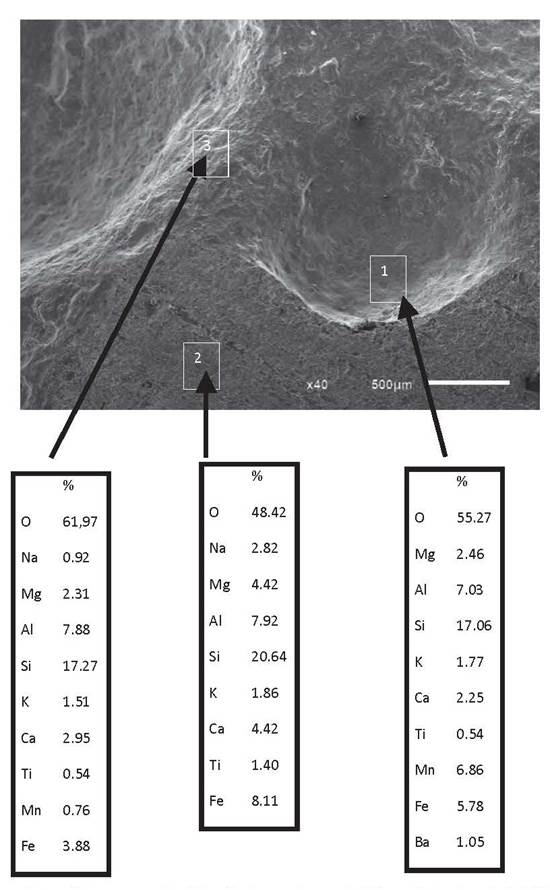
Figure 11 Elemental composition of desert varnish films (microprobe analysis) on olivine basalt (pit Sim), cross-section of the bubble cavity on the lava surface: 1 - thick varnish film; 2 - cut-rock; 3 - thin varnish film (SEM secondary electron mode, mass %).
Extremely arid soils of Mongolia are characterized by climate-induced formation of solonchakous features (Evstifeev, 1977). Hence, desert soil solutions are saline, dominated by sulphates. In this case, microorganisms oxidizing organic matter have to use sulphate ions from the soil solution as electron acceptors (Cypionka, 2000):
Iron and manganese reduction within the crust horizon was confirmed by direct observations using the ‘agar-covered fouling glasses’ method (Lebedeva and Kutovaya, 2013). However, sulphate reduction with intermediate production of FeS and MnS has to be regarded as a hypothetical process:
Barium accumulation within the film of desert varnish is an additional argument in support of sulphate reduction as an intermediate stage of the cryptosolodization process-solodization on the microlevel. ‘Solodization’ in Russian terms means the development of redoximorphic features in the presence of salts (Tursina, 1966; Golovanovet al., 2005). Barium is almost entirely immobilized in the presence of sulphates, while in the presence of sulphides Ba2+is extremely soluble (Kasimov, 1988). Dissolved barium and manganese migrate with pellicular moisture flow towards the surface of desert pavement. The ions of Mn2+, as opposed to Fe2+, are mobile under neutral and weakly alkaline conditions, thereby causing mostly black colour of desert pavement due to the prevalence of Mn over Fe. Manganese has changed its rank from micro- to macro-element within the dark, almost black films of desert varnish.
The chemical composition of desert varnish does not depend on bedrock composition, but it depends on the microtopography of rock surfaces (figures 11, 12).
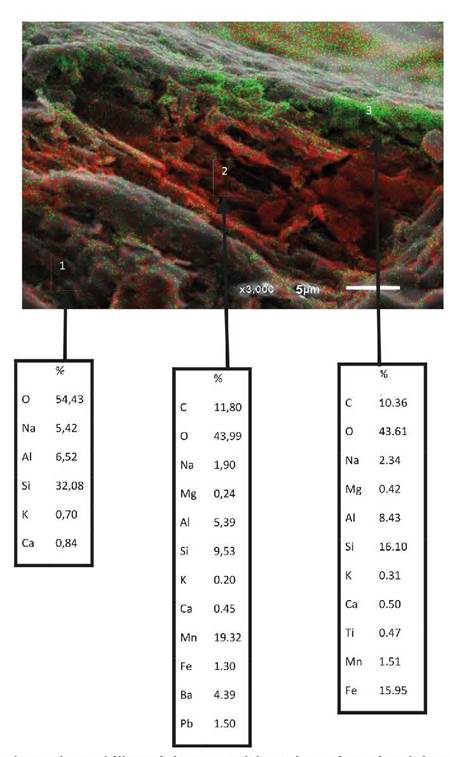
Figure 12 Element distribution in two-layered films of desert varnish on the surface of rock fragments from pit PAN-28 (Mojave) and microprobe analysis: 1-cut rock, 2-lower layer of the film, and 3-upper layer of the film (oblique view, SEM, mass %).
The exposed surfaces of rock fragments of desert pavements are covered mostly by silicate-ferruginous films, while micro-cavities in those rocks usually bear two-layered films: the lower layer with the prevalence of manganese and increased concentration of barium, and the upper layer with the prevalence of iron and accumulation of titanium (Figures 12, 13, 14).
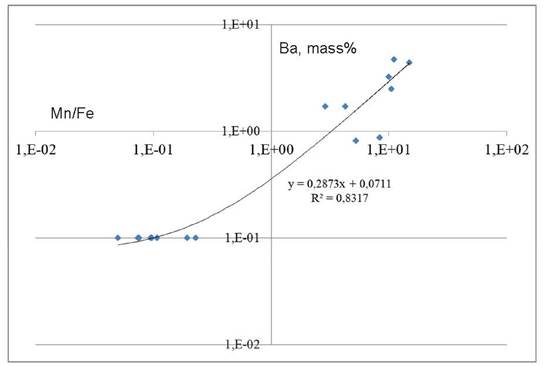
Figure 13 Relationship between the contents of Ba (mass %) and the Mn/Fe ratio within the films of desert varnish of both deserts.
Similar features were earlier reported in deserts in the western USA, but without interpretation of their genesis. In addition to the suggested ‘explosive’ development of two-layered films after rainfall events (Golovanov et al., 2016), there is an alternative explanation of microlamination based on climate change (McFadden et al., 1986; Liu and Broecker, 2007, 2008; Dorn, 2009).
After a partial evaporation of moisture from the crust horizon, FeS oxidation leads to an intermediate production of sulphuric acid, lowering of pH, bleaching around pores, migration of dissolved iron and titanium to the surface of desert pavement as well as to the middle horizon and lower sides of rock fragments, which is clearly manifested in red (not black) films (Figure 2).
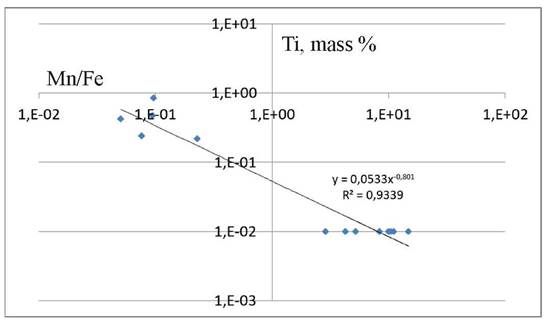
Figure 14 Relationship between the contents of Ti (mass %) and the Mn/Fe ratio within the films of desert varnish of both deserts.
The abrupt change of geochemical environments at the alternation of regimes of moistening of the crust horizon leads to the amorphization of layered aluminosilicates (Figure 3).
5. Conclusions
The present study on desert varnish and the vesicular horizon of extremely arid soils in the USA and Mongolia is based on a combined application of scanning electron microscopy, micromorphology and tomography. Micromorphological features show iron mobilization under anaerobic conditions in general (though with micro-aerobic zones), which include iron depletion pedofeatures around pores and ferruginous micro-concentrations. The upper black film on the surface of stony pavement contains an increased amount of manganese. The lower layer (with brownish-red colour), unlike the upper layer, is characterized by the absence of manganese. The surface double-layered films of desert varnish retain the same composition and Fe/Ti and Mn/Ba ratios independently from the initial composition of parent materials and geographical location of the study regions. We offer an explanation of both phenomena of desert pedogenesis -light-coloured crust horizon and dark-coloured desert varnish-based on a combined hydrophysical-biogeochemical mechanism that causes a burst of microbiological activity and physicochemical processes following rare, but heavy showers during the hot season. Despite its transitory character, the process, which we suggest to call ‘cryptosolodization’, includes five stages: (1) Fe, Mn and sulphate reduction with mobilization of Ba2+from BaSO4, (2) precipitation of FeS and migration of Ba2+and Mn2+to the stone surface, (3) coprecipitation of Ba and Mn at a combined oxygen-sorption barrier, (4) oxidation of S2-to SO4 2-with mobilization of Ti2+from TiO2and (5) oxidation of Ti2+and Fe2+and their coprecipitation in the form of oxides TiO2and Fe(OH)3.
In contrast to the accretion hypothesis, which explains the occurrence of desert varnish by atmospheric and even cosmogenic precipitation, we suggest that the development of desert varnish is caused by the ascending migration of film moisture containing manganese to the surface of desert pavement.











 nueva página del texto (beta)
nueva página del texto (beta)

